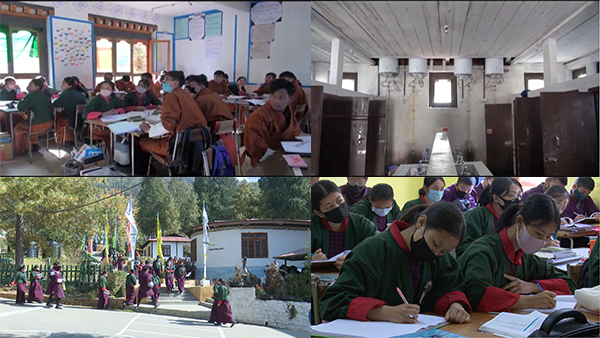 With schools remaining open throughout this winter to cover up the syllabus that was missed because of the COVID-19 situation, schools in cold places are gearing up to beat the cold. And this could be a challenge when research findings on the thermal performance of school buildings in the cold climate of Bhutan show that the buildings are far from being energy efficient.
With schools remaining open throughout this winter to cover up the syllabus that was missed because of the COVID-19 situation, schools in cold places are gearing up to beat the cold. And this could be a challenge when research findings on the thermal performance of school buildings in the cold climate of Bhutan show that the buildings are far from being energy efficient.
Beginning March, with the country’s first COVID 19 positive case, schools across the country were closed. The on-campus learning was interrupted for months due to the coronavirus pandemic along with a month-long nationwide lockdown. Fast forward to September, schools for classes IX-XII reopened. Now this cold winter, the classes are in full session until next year.
“It will be inconvenient in school if students are cold. Even us, we can’t bring proper output when we are cold. It is same with our children. If it’s too cold, there are chances that they might suffer from the disease called Chilblains. Also when it’s cold, they wouldn’t be able to do their class activities,” said Karma Wangchuk, the Chief Programme Officer with the Department of School Education at the Education Ministry.
In one of the studies conducted in Bhutan on the thermal performance of school buildings in the cold climate of Bhutan, Bhutanese researchers have found out that school buildings in Bhutan are far from being energy efficient. Today more than 100 out of 575 schools in Bhutan are located in cold regions. And these schools do not have adequate heating system either in the classrooms or in the hostels.
Studies have indicated a direct correlation between thermal comfort and the workers’ output. This also applies to teaching and learning activities. For example, more than 240 students in Thimphu, Paro, and Wangdue were reported to be suffering from chilblains which is caused due to prolonged exposure to cold weather before.
The Education Ministry, however, says that they have taken into account the needs that school children will have this winter.
“It’s cold everywhere in Bhutan, be it Gasa or Phuentshogling. But in places where there is extreme cold, example in Bumthang, they will use Bukhari (a wood-burning stove). And in Paro, they have bought a heating system. In Gasa also, we have higher classes and the authorities there have submitted a proposal to us saying that the classes from extreme places there be shifted to Geshong,” he added.
He also says students will be allowed to wear jackets and hand gloves which otherwise is not allowed on the campus.
In Bumthang, for example, classrooms are fitted with Bukharis in Ura Central School which is the coldest of all schools in Bumthang. At Jakar Higher Secondary School which has over 740 students, the highest in the district, 10 new geysers have been provided. The school also has a solar-hot water plant but during winter and cloudy days, the facility mostly remains dysfunctional.
“In Jakar HSS, we give students warm water to wash their hands. We also have a dispenser for them to drink. They have geysers in their hostel. We have 14 Geysers, eight for the girls and six for the boys,” said Ngawang Jamtsho, the Principal of Jakar HSS.
While students will have to bear the brunt of the pandemic this cold winter, researchers also say that one of the serious problems with the modern Bhutanese buildings that need to be looked into is the excessive infiltration or air leakage. Air leakage is responsible for more than 30% of the heating load in cold climates.
For now, the researchers say that the simplest and cheapest intervention is sealing the gaps between the building elements which doesn’t cost much. By simply sealing the gaps, it will be warmer by 2°C inside the building on an average.
Samten Dolkar












